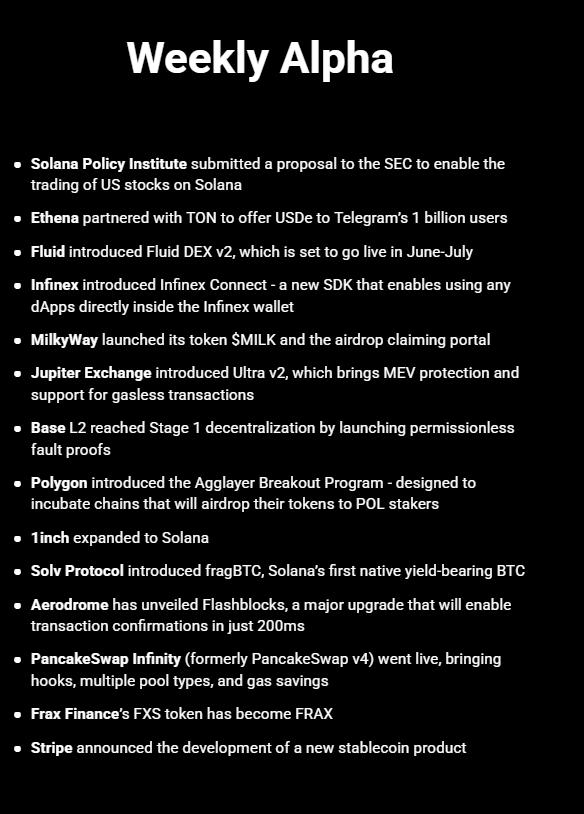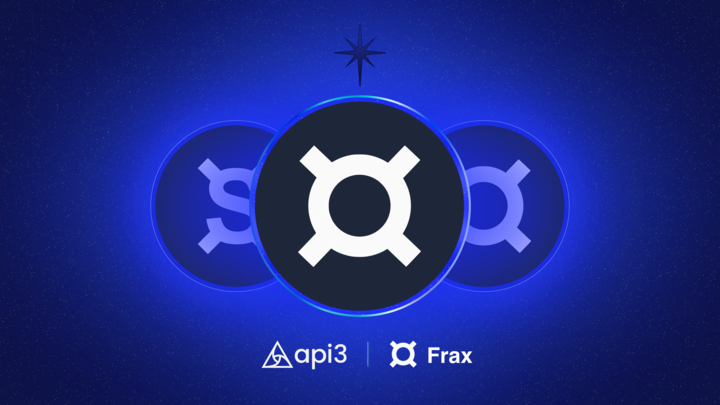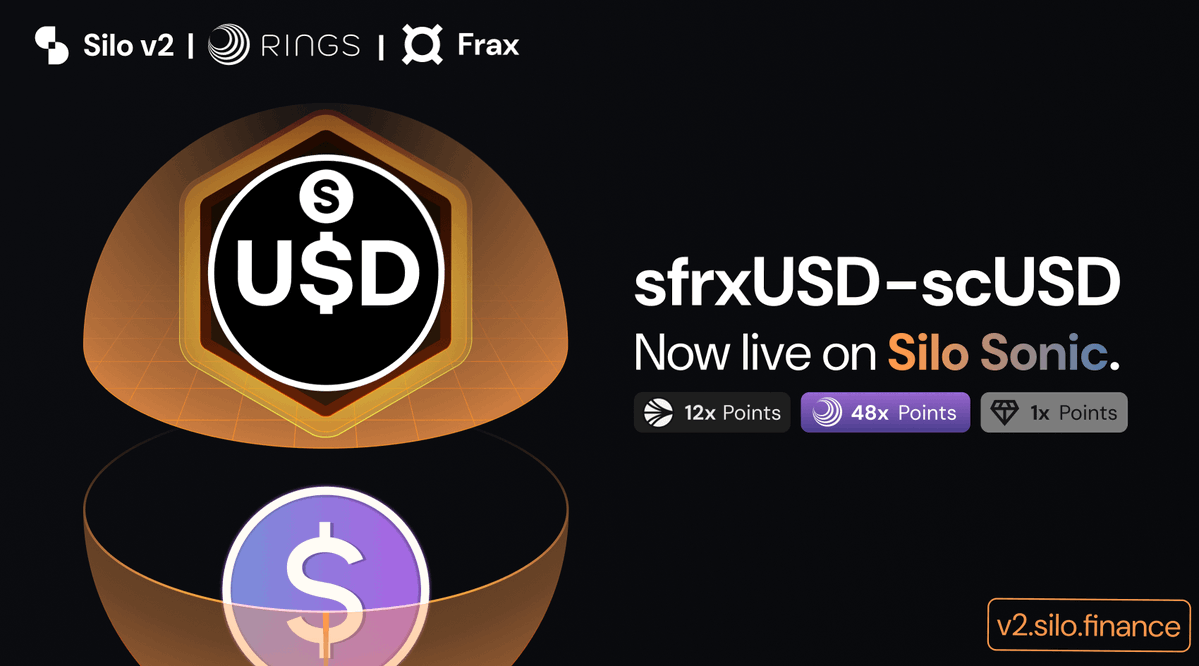
FXS
Preț Frax Share
$2,4630
+$0,055000
(+2,28 %)
Schimbare de preț pentru ultimele 24 de ore

Ce simțiți despre FXS azi?
Partajați-vă sentimentele aici oferind o apreciere dacă simțiți că va exista o creștere a monedei sau o respingere dacă simțiți că va exista o scădere.
Votați pentru a vedea rezultatele
Limitarea răspunderii
Conținutul social de pe această pagină („Conținutul”), include fără a se limita la tweeturi și statistici furnizate de LunarCrush, este obținut de la terți și este furnizat „așa cum este” pentru a fi folosit doar în scopuri informative. OKX nu garantează calitatea sau acuratețea conținutului, iar conținutul nu reprezintă opiniile OKX. Acesta nu este menit să ofere (i) sfaturi sau recomandări investiționale; (ii) o ofertă sau solicitare de a cumpăra, vinde sau deține active digitale; sau (iii) sfaturi financiare, contabile, juridice sau fiscale. Activele digitale, inclusiv criptomonedele stabile și NFT-urile, implică un grad ridicat de risc, pot fluctua considerabil. Prețul și performanța activelor digitale nu sunt garantate și se pot modifica fără notificare.
OKX nu furnizează recomandări privind investițiile sau activele. Trebuie să analizați cu atenție dacă să tranzacționați sau să dețineți activele digitale prin prisma stării dvs. financiare. Consultați-vă cu un profesionist în domeniul juridic / fiscal / de investiții pentru întrebări despre circumstanțele dumneavoastră specifice. Pentru detalii suplimentare, consultați Condițiile de utilizare și Avertizarea de risc. Prin utilizarea paginii web terțe („TPW”), acceptați că orice utilizare a unei TPW va fi supusă oricăror și guvernată de orice condiții pentru TPW. Exceptând mențiunile exprese în scris, OKX și afiliații săi („OKX”) nu sunt în niciun fel asociați cu proprietarul sau operatorul TPW. Sunteți de acord că OKX nu este responsabilă sau răspunzătoare pentru nicio pierdere, daună și orice alte consecințe care decurg din utilizarea de către dumneavoastră a unei TPW. Țineți cont că utilizarea TPW poate duce la pierderea sau diminuarea activelor dumneavoastră. Este posibil ca produsul să nu fie disponibil în toate jurisdicțiile.
OKX nu furnizează recomandări privind investițiile sau activele. Trebuie să analizați cu atenție dacă să tranzacționați sau să dețineți activele digitale prin prisma stării dvs. financiare. Consultați-vă cu un profesionist în domeniul juridic / fiscal / de investiții pentru întrebări despre circumstanțele dumneavoastră specifice. Pentru detalii suplimentare, consultați Condițiile de utilizare și Avertizarea de risc. Prin utilizarea paginii web terțe („TPW”), acceptați că orice utilizare a unei TPW va fi supusă oricăror și guvernată de orice condiții pentru TPW. Exceptând mențiunile exprese în scris, OKX și afiliații săi („OKX”) nu sunt în niciun fel asociați cu proprietarul sau operatorul TPW. Sunteți de acord că OKX nu este responsabilă sau răspunzătoare pentru nicio pierdere, daună și orice alte consecințe care decurg din utilizarea de către dumneavoastră a unei TPW. Țineți cont că utilizarea TPW poate duce la pierderea sau diminuarea activelor dumneavoastră. Este posibil ca produsul să nu fie disponibil în toate jurisdicțiile.
Informații de piață despre Frax Share
Capitalizare de piață
Capitalizarea de piață este calculată prin multiplicarea ofertei în circulație a unei monede cu ultimul său preț.
Capitalizare de piață = Ofertă în circulație x Ultimul preț
Capitalizare de piață = Ofertă în circulație x Ultimul preț
Ofertă în circulație
Suma totală a unei monede care este disponibilă public pe piață.
Clasament capitalizare de piață
Clasamentul unei monede după valoarea capitalizării de piață.
Maxim istoric
Cel mai mare preț atins de o monedă în istoricul său de tranzacționare.
Minim istoric
Cel mai mic preț atins de o monedă în istoricul său de tranzacționare.
Capitalizare de piață
$221,30M
Ofertă în circulație
89.886.433 FXS
90,17 % din
99.681.496 FXS
Clasament capitalizare de piață
119
Audituri

Ultimul audit: 23 mai 2021
Max. 24 h
$2,5250
Min. 24 h
$2,3940
Maxim istoric
$11,0000
-77,61 % (-$8,5370)
Ultima actualizare: 6 iul. 2023
Minim istoric
$1,2460
+97,67 % (+$1,2170)
Ultima actualizare: 11 mar. 2025
Flux Frax Share
Acest conținut provine de la .

Mars_DeFi a repostat

The DeFi Investor 🔎
Cele mai recente evoluții👇 DeFi
Solana Policy Institute a prezentat o propunere SEC pentru a permite tranzacționarea acțiunilor americane pe Solana
Ethena a încheiat un parteneriat cu TON pentru a oferi USDe celor 1 miliard de utilizatori ai Telegram
Fluid a introdus Fluid DEX v2, care va fi lansat în iunie-iulie. DEX V2 va îmbunătăți semnificativ eficiența capitalului și va introduce cârlige
Infinex a introdus Infinex Connect - un nou SDK care permite utilizarea oricăror dApps direct în portofelul Infinex
MilkyWay și-a lansat tokenul MILK și portalul de revendicare a airdrop-ului
Jupiter Exchange a introdus Ultra v2, care aduce protecție MEV și suport pentru tranzacții fără gaz
Baza L2 a atins Etapa 1 de descentralizare prin lansarea proof-urilor fără permisiune
Polygon a introdus programul Agglayer Breakout - conceput pentru a incuba lanțuri care își vor lansa jetoanele către participanții POL
1inch extins la Solana
Solv Protocol a introdus fragBTC, primul BTC nativ cu randament al Solana
Aerodrome a dezvăluit Flashblocks, o actualizare majoră care va permite confirmarea tranzacțiilor în doar 200 ms
PancakeSwap Infinity (fostul PancakeSwap v4) a fost lansat, aducând cârlige, mai multe tipuri de piscine și economii de gaz
Tokenul FXS al Frax Finance a devenit FRAX
Stripe a anunțat dezvoltarea unui nou produs stablecoin
Asta e tot pentru azi.
Dacă ți-a plăcut să citești acest articol, un like și un retweet ar fi foarte apreciate🫡
Afișare original
6,38 K
40

The DeFi Investor 🔎
Cele mai recente evoluții👇 DeFi
Solana Policy Institute a prezentat o propunere SEC pentru a permite tranzacționarea acțiunilor americane pe Solana
Infinex a introdus Infinex Connect - un nou SDK care permite utilizarea oricăror dApps direct în portofelul Infinex
Fluid a introdus Fluid DEX v2, care va fi lansat în iunie-iulie. DEX V2 va îmbunătăți semnificativ eficiența capitalului și va introduce cârlige
Ethena a încheiat un parteneriat cu TON pentru a oferi USDe celor 1 miliard de utilizatori ai Telegram
MilkyWay și-a lansat tokenul MILK și portalul de revendicare a airdrop-ului
Jupiter Exchange a introdus Ultra v2, care aduce protecție MEV și suport pentru tranzacții fără gaz
Baza L2 a atins Etapa 1 de descentralizare prin lansarea proof-urilor fără permisiune
Polygon a introdus programul Agglayer Breakout - conceput pentru a incuba lanțuri care își vor lansa jetoanele către participanții POL
1inch extins la Solana
Solv Protocol a introdus fragBTC, primul BTC nativ cu randament al Solana
Aerodrome a dezvăluit Flashblocks, o actualizare majoră care va permite confirmarea tranzacțiilor în doar 200 ms
PancakeSwap Infinity (fostul PancakeSwap v4) a fost lansat, aducând cârlige, mai multe tipuri de piscine și economii de gaz
Tokenul FXS al Frax Finance a devenit FRAX
Stripe a anunțat dezvoltarea unui nou produs stablecoin
Asta e tot pentru azi.
Dacă ți-a plăcut să citești acest articol, un like și un retweet ar fi foarte apreciate🫡
Afișare original7,3 K
20




Frax Finance ¤⛓️¤
1/ Astăzi, Frax Share $FXS devine Frax $FRAX, singurul token de marfă pentru ecosistemul nostru. Modificări ale adresei contractului mai jos:
CA curent pentru FXS pe Ethereum:
0x3432b6a60d23ca0dfca7761b7ab56459d9c964d0
CA curent pentru FXS pe Fraxtal:
0xFc00000000000000000000000000000000000002

Frax Finance ¤⛓️¤
1/ Pe 29 aprilie, la prânz PST, Frax face următorul pas în evoluția noastră cu actualizarea North Star ⭐️
Cu această actualizare, Frax Share va fi redenumit pur și simplu în Frax, va deveni jetonul de gaz pentru Fraxtal și va fi singurul token de marfă utilizat pentru securitate în ecosistem pentru totdeauna.
👇
15,54 K
141

Api3
🚨 Pe 29 aprilie, 19:00 UTC, @fraxfinance evoluează cu hard fork-ul North Star! $FXS devine $FRAX – acum tokenul de gaz pentru Fraxtal și singurul token de marfă pentru securitate. Această actualizare de redenumire @fraxfinance poate afecta unele dApps și utilizatori 👇 Api3
Afișare original
4,68 K
27

Silo Intern a repostat

Silo Labs (v2 is live)
O nouă buclă de stablecoin a sosit la Silo Sonic cu cel mai recent siloz sfrxUSD-scUSD.
Alege-ți strategia:
🅰️ Buclă sfrxUSD față de scUSD pentru randamentul cu efect de levier
🅱️ Împrumutați scUSD pentru dobândă, inele și puncte sonice
Ambele căi vin cu o porție sănătoasă de puncte siloz.
👇

14,56 K
29
Calculator FXS


Performanța prețului Frax Share în USD
Prețul actual al Frax Share este $2,4630. În ultimele 24 de ore, Frax Share a crescut cu +2,28 %. În prezent are o ofertă în circulație de 89.886.433 FXS și o ofertă maximă de 99.681.496 FXS, asigurând o capitalizare de piață diluată complet de $221,30M. În prezent, moneda Frax Share deține poziția 119 în clasamentul capitalizării de piață. Prețul Frax Share/USD este actualizat în timp real.
Astăzi
+$0,055000
+2,28 %
7 zile
+$0,28000
+12,82 %
30 de zile
+$0,50700
+25,92 %
3 luni
-$0,13200
-5,09 %
Conversii Frax Share populare
Ultima actualizare: 02.05.2025, 04:42
| 1 FXS în USD | 2,4620 $ |
| 1 FXS în EUR | 2,1810 € |
| 1 FXS în PHP | 137,55 ₱ |
| 1 FXS în IDR | 40.910,60 Rp |
| 1 FXS în GBP | 1,8541 £ |
| 1 FXS în CAD | 3,4088 $ |
| 1 FXS în AED | 9,0429 AED |
| 1 FXS în VND | 64.031,21 ₫ |
Despre Frax Share (FXS)
Ratingul furnizat este un rating cumulat colectat de către OKX din sursele furnizate și poate fi folosit doar în scopuri informative. OKX nu garantează calitatea sau acuratețea ratingurilor. Ratingul nu este menit să ofere (i) sfaturi sau recomandări investiționale; (ii) o ofertă sau solicitare de a cumpăra, vinde sau deține active digitale; sau (iii) sfaturi financiare, contabile, juridice sau fiscale. Activele digitale, inclusiv criptomonedele stabile și NFT-urile, implică un grad ridicat de risc, pot fluctua considerabil și chiar își pot pierde valoarea. Prețul și performanța activelor digitale nu sunt garantate și se pot modifica fără notificare. Activele dvs. digitale nu sunt acoperite de asigurare împotriva pierderilor potențiale. Profiturile istorice nu sunt reprezentative pentru profiturile viitoare. OKX nu garantează niciun profit și nicio rambursare a capitalului inițial sau a dobânzii. OKX nu furnizează recomandări privind investițiile sau activele. Ar trebui să analizați cu atenție dacă tranzacționarea sau deținerea de active digitale este potrivită pentru dvs., având în vedere situația dvs. financiară. Consultați-vă cu un profesionist în domeniul juridic/fiscal/investiții pentru întrebări despre circumstanțele dvs. specifice.
Afișează mai multe
- Pagina web oficială
- Explorator bloc
Despre paginile web ale unor terți
Despre paginile web ale unor terți
Prin utilizarea paginii web terțe („TPW”), acceptați că orice utilizare a unei TPW va fi supusă și guvernată de condițiile pentru TPW. Exceptând mențiunile exprese în scris, OKX și afiliații săi („OKX”) nu sunt asociați cu proprietarul sau operatorul TPW. Sunteți de acord că OKX nu este responsabilă sau răspunzătoare pentru nicio pierdere, daună sau orice alte consecințe care decurg din utilizarea de către dvs. a unei TPW. Țineți cont că utilizarea TPW poate duce la pierderea sau diminuarea activelor dvs.
Întrebări frecvente Frax Share
Cât valorează 1 Frax Share azi?
În prezent, un Frax Share valorează $2,4630. Pentru răspunsuri și informații privind acțiunea prețului Frax Share, sunteți în locul potrivit. Explorați cele mai recente grafice pentru Frax Share și tranzacționați în mod responsabil cu OKX.
Ce este criptomoneda?
Criptomonedele, de exemplu Frax Share, sunt active digitale care operează pe un registru public denumit blockchain. Aflați mai multe despre monedele și tokenurile oferite pe OKX și atributele lor diferite, care includ prețuri în direct și grafice în timp real.
Când a fost inventată criptomoneda?
Datorită crizei financiare din 2008, interesul față de finanțele descentralizate a luat amploare. Bitcoin a oferit o soluție nouă prin faptul că era un activ digital sigur pe o rețea descentralizată. De atunci, au fost create multe alte tokenuri, precum Frax Share.
Va crește prețul Frax Share azi?
Consultați Pagină de predicție de preț pentru Frax Share pentru a prezice prețurile viitoare și a vă determina prețurile țintă.
Raportare privind gazele cu efect de seră
Reglementările ESG (de mediu, sociale și de guvernanță) pentru activele cripto își propun să-și gestioneze impactul asupra mediului (de exemplu, minerit care necesită un consum mare de energie), să promoveze transparența și să asigure practici de guvernanță etice în vederea alinierii domeniului cripto la scopurile de sustenabilitate și sociale mai generale. Aceste reglementări încurajează conformitatea cu standarde care minimalizează riscurile și susțin încrederea în activele digitale.
Detaliile activului
Nume
OKcoin Europe LTD
Identificatorul relevant al persoanei juridice
54930069NLWEIGLHXU42
Numele activului cripto
Frax Share
Mecanism de consens
Frax Share is present on the following networks: arbitrum, avalanche, binance_smart_chain, ethereum, fantom, solana.
Arbitrum is a Layer 2 solution on top of Ethereum that uses Optimistic Rollups to enhance scalability and reduce transaction costs. It assumes that transactions are valid by default and only verifies them if there's a challenge (optimistic): Core Components: • Sequencer: Orders transactions and creates batches for processing. • Bridge: Facilitates asset transfers between Arbitrum and Ethereum. • Fraud Proofs: Protect against invalid transactions through an interactive verification process. Verification Process: 1. Transaction Submission: Users submit transactions to the Arbitrum Sequencer, which orders and batches them. 2. State Commitment: These batches are submitted to Ethereum with a state commitment. 3. Challenge Period: Validators have a specific period to challenge the state if they suspect fraud. 4. Dispute Resolution: If a challenge occurs, the dispute is resolved through an iterative process to identify the fraudulent transaction. The final operation is executed on Ethereum to determine the correct state. 5. Rollback and Penalties: If fraud is proven, the state is rolled back, and the dishonest party is penalized. Security and Efficiency: The combination of the Sequencer, bridge, and interactive fraud proofs ensures that the system remains secure and efficient. By minimizing on-chain data and leveraging off-chain computations, Arbitrum can provide high throughput and low fees.
The Avalanche blockchain network employs a unique Proof-of-Stake consensus mechanism called Avalanche Consensus, which involves three interconnected protocols: Snowball, Snowflake, and Avalanche. Avalanche Consensus Process 1. Snowball Protocol: o Random Sampling: Each validator randomly samples a small, constant-sized subset of other validators. Repeated Polling: Validators repeatedly poll the sampled validators to determine the preferred transaction. Confidence Counters: Validators maintain confidence counters for each transaction, incrementing them each time a sampled validator supports their preferred transaction. Decision Threshold: Once the confidence counter exceeds a pre-defined threshold, the transaction is considered accepted. 2. Snowflake Protocol: Binary Decision: Enhances the Snowball protocol by incorporating a binary decision process. Validators decide between two conflicting transactions. Binary Confidence: Confidence counters are used to track the preferred binary decision. Finality: When a binary decision reaches a certain confidence level, it becomes final. 3. Avalanche Protocol: DAG Structure: Uses a Directed Acyclic Graph (DAG) structure to organize transactions, allowing for parallel processing and higher throughput. Transaction Ordering: Transactions are added to the DAG based on their dependencies, ensuring a consistent order. Consensus on DAG: While most Proof-of-Stake Protocols use a Byzantine Fault Tolerant (BFT) consensus, Avalanche uses the Avalanche Consensus, Validators reach consensus on the structure and contents of the DAG through repeated Snowball and Snowflake.
Binance Smart Chain (BSC) uses a hybrid consensus mechanism called Proof of Staked Authority (PoSA), which combines elements of Delegated Proof of Stake (DPoS) and Proof of Authority (PoA). This method ensures fast block times and low fees while maintaining a level of decentralization and security. Core Components 1. Validators (so-called “Cabinet Members”): Validators on BSC are responsible for producing new blocks, validating transactions, and maintaining the network’s security. To become a validator, an entity must stake a significant amount of BNB (Binance Coin). Validators are selected through staking and voting by token holders. There are 21 active validators at any given time, rotating to ensure decentralization and security. 2. Delegators: Token holders who do not wish to run validator nodes can delegate their BNB tokens to validators. This delegation helps validators increase their stake and improves their chances of being selected to produce blocks. Delegators earn a share of the rewards that validators receive, incentivizing broad participation in network security. 3. Candidates: Candidates are nodes that have staked the required amount of BNB and are in the pool waiting to become validators. They are essentially potential validators who are not currently active but can be elected to the validator set through community voting. Candidates play a crucial role in ensuring there is always a sufficient pool of nodes ready to take on validation tasks, thus maintaining network resilience and decentralization. Consensus Process 4. Validator Selection: Validators are chosen based on the amount of BNB staked and votes received from delegators. The more BNB staked and votes received, the higher the chance of being selected to validate transactions and produce new blocks. The selection process involves both the current validators and the pool of candidates, ensuring a dynamic and secure rotation of nodes. 5. Block Production: The selected validators take turns producing blocks in a PoA-like manner, ensuring that blocks are generated quickly and efficiently. Validators validate transactions, add them to new blocks, and broadcast these blocks to the network. 6. Transaction Finality: BSC achieves fast block times of around 3 seconds and quick transaction finality. This is achieved through the efficient PoSA mechanism that allows validators to rapidly reach consensus. Security and Economic Incentives 7. Staking: Validators are required to stake a substantial amount of BNB, which acts as collateral to ensure their honest behavior. This staked amount can be slashed if validators act maliciously. Staking incentivizes validators to act in the network's best interest to avoid losing their staked BNB. 8. Delegation and Rewards: Delegators earn rewards proportional to their stake in validators. This incentivizes them to choose reliable validators and participate in the network’s security. Validators and delegators share transaction fees as rewards, which provides continuous economic incentives to maintain network security and performance. 9. Transaction Fees: BSC employs low transaction fees, paid in BNB, making it cost-effective for users. These fees are collected by validators as part of their rewards, further incentivizing them to validate transactions accurately and efficiently.
The Ethereum network uses a Proof-of-Stake Consensus Mechanism to validate new transactions on the blockchain. Core Components 1. Validators: Validators are responsible for proposing and validating new blocks. To become a validator, a user must deposit (stake) 32 ETH into a smart contract. This stake acts as collateral and can be slashed if the validator behaves dishonestly. 2. Beacon Chain: The Beacon Chain is the backbone of Ethereum 2.0. It coordinates the network of validators and manages the consensus protocol. It is responsible for creating new blocks, organizing validators into committees, and implementing the finality of blocks. Consensus Process 1. Block Proposal: Validators are chosen randomly to propose new blocks. This selection is based on a weighted random function (WRF), where the weight is determined by the amount of ETH staked. 2. Attestation: Validators not proposing a block participate in attestation. They attest to the validity of the proposed block by voting for it. Attestations are then aggregated to form a single proof of the block’s validity. 3. Committees: Validators are organized into committees to streamline the validation process. Each committee is responsible for validating blocks within a specific shard or the Beacon Chain itself. This ensures decentralization and security, as a smaller group of validators can quickly reach consensus. 4. Finality: Ethereum 2.0 uses a mechanism called Casper FFG (Friendly Finality Gadget) to achieve finality. Finality means that a block and its transactions are considered irreversible and confirmed. Validators vote on the finality of blocks, and once a supermajority is reached, the block is finalized. 5. Incentives and Penalties: Validators earn rewards for participating in the network, including proposing blocks and attesting to their validity. Conversely, validators can be penalized (slashed) for malicious behavior, such as double-signing or being offline for extended periods. This ensures honest participation and network security.
Fantom operates on the Lachesis Protocol, an Asynchronous Byzantine Fault Tolerant (aBFT) consensus mechanism designed for fast, secure, and scalable transactions. Core Components of Fantom’s Consensus: 1. Lachesis Protocol (aBFT): Asynchronous and Leaderless: Lachesis allows nodes to reach consensus independently without relying on a central leader, enhancing decentralization and speed. DAG Structure: Instead of a linear blockchain, Lachesis uses a Directed Acyclic Graph (DAG) structure, allowing multiple transactions to be processed in parallel across nodes. This structure supports high throughput, making the network suitable for applications requiring rapid transaction processing. 2. Event Blocks and Instant Finality: Event Blocks: Transactions are grouped into event blocks, which are validated asynchronously by multiple validators. When enough validators confirm an event block, it becomes part of the Fantom network’s history. Instant Finality: Transactions on Fantom achieve immediate finality, meaning they are confirmed and cannot be reversed. This property is ideal for applications requiring fast and irreversible transactions.
Solana uses a unique combination of Proof of History (PoH) and Proof of Stake (PoS) to achieve high throughput, low latency, and robust security. Here’s a detailed explanation of how these mechanisms work: Core Concepts 1. Proof of History (PoH): Time-Stamped Transactions: PoH is a cryptographic technique that timestamps transactions, creating a historical record that proves that an event has occurred at a specific moment in time. Verifiable Delay Function: PoH uses a Verifiable Delay Function (VDF) to generate a unique hash that includes the transaction and the time it was processed. This sequence of hashes provides a verifiable order of events, enabling the network to efficiently agree on the sequence of transactions. 2. Proof of Stake (PoS): Validator Selection: Validators are chosen to produce new blocks based on the number of SOL tokens they have staked. The more tokens staked, the higher the chance of being selected to validate transactions and produce new blocks. Delegation: Token holders can delegate their SOL tokens to validators, earning rewards proportional to their stake while enhancing the network's security. Consensus Process 1. Transaction Validation: Transactions are broadcast to the network and collected by validators. Each transaction is validated to ensure it meets the network’s criteria, such as having correct signatures and sufficient funds. 2. PoH Sequence Generation: A validator generates a sequence of hashes using PoH, each containing a timestamp and the previous hash. This process creates a historical record of transactions, establishing a cryptographic clock for the network. 3. Block Production: The network uses PoS to select a leader validator based on their stake. The leader is responsible for bundling the validated transactions into a block. The leader validator uses the PoH sequence to order transactions within the block, ensuring that all transactions are processed in the correct order. 4. Consensus and Finalization: Other validators verify the block produced by the leader validator. They check the correctness of the PoH sequence and validate the transactions within the block. Once the block is verified, it is added to the blockchain. Validators sign off on the block, and it is considered finalized. Security and Economic Incentives 1. Incentives for Validators: Block Rewards: Validators earn rewards for producing and validating blocks. These rewards are distributed in SOL tokens and are proportional to the validator’s stake and performance. Transaction Fees: Validators also earn transaction fees from the transactions included in the blocks they produce. These fees provide an additional incentive for validators to process transactions efficiently. 2. Security: Staking: Validators must stake SOL tokens to participate in the consensus process. This staking acts as collateral, incentivizing validators to act honestly. If a validator behaves maliciously or fails to perform, they risk losing their staked tokens. Delegated Staking: Token holders can delegate their SOL tokens to validators, enhancing network security and decentralization. Delegators share in the rewards and are incentivized to choose reliable validators. 3. Economic Penalties: Slashing: Validators can be penalized for malicious behavior, such as double-signing or producing invalid blocks. This penalty, known as slashing, results in the loss of a portion of the staked tokens, discouraging dishonest actions.
Mecanisme de stimulare și comisioane aplicabile
Frax Share is present on the following networks: arbitrum, avalanche, binance_smart_chain, ethereum, fantom, solana.
Arbitrum One, a Layer 2 scaling solution for Ethereum, employs several incentive mechanisms to ensure the security and integrity of transactions on its network. The key mechanisms include: 1. Validators and Sequencers: o Sequencers are responsible for ordering transactions and creating batches that are processed off-chain. They play a critical role in maintaining the efficiency and throughput of the network. o Validators monitor the sequencers' actions and ensure that transactions are processed correctly. Validators verify the state transitions and ensure that no invalid transactions are included in the batches. 2. Fraud Proofs: o Assumption of Validity: Transactions processed off-chain are assumed to be valid. This allows for quick transaction finality and high throughput. o Challenge Period: There is a predefined period during which anyone can challenge the validity of a transaction by submitting a fraud proof. This mechanism acts as a deterrent against malicious behavior. o Dispute Resolution: If a challenge is raised, an interactive verification process is initiated to pinpoint the exact step where fraud occurred. If the challenge is valid, the fraudulent transaction is reverted, and the dishonest actor is penalized. 3. Economic Incentives: o Rewards for Honest Behavior: Participants in the network, such as validators and sequencers, are incentivized through rewards for performing their duties honestly and efficiently. These rewards come from transaction fees and potentially other protocol incentives. o Penalties for Malicious Behavior: Participants who engage in dishonest behavior or submit invalid transactions are penalized. This can include slashing of staked tokens or other forms of economic penalties, which serve to discourage malicious actions. Fees on the Arbitrum One Blockchain 1. Transaction Fees: o Layer 2 Fees: Users pay fees for transactions processed on the Layer 2 network. These fees are typically lower than Ethereum mainnet fees due to the reduced computational load on the main chain. o Arbitrum Transaction Fee: A fee is charged for each transaction processed by the sequencer. This fee covers the cost of processing the transaction and ensuring its inclusion in a batch. 2. L1 Data Fees: o Posting Batches to Ethereum: Periodically, the state updates from the Layer 2 transactions are posted to the Ethereum mainnet as calldata. This involves a fee, known as the L1 data fee, which accounts for the gas required to publish these state updates on Ethereum. o Cost Sharing: Because transactions are batched, the fixed costs of posting state updates to Ethereum are spread across multiple transactions, making it more cost-effective for users.
Avalanche uses a consensus mechanism known as Avalanche Consensus, which relies on a combination of validators, staking, and a novel approach to consensus to ensure the network's security and integrity. Validators: Staking: Validators on the Avalanche network are required to stake AVAX tokens. The amount staked influences their probability of being selected to propose or validate new blocks. Rewards: Validators earn rewards for their participation in the consensus process. These rewards are proportional to the amount of AVAX staked and their uptime and performance in validating transactions. Delegation: Validators can also accept delegations from other token holders. Delegators share in the rewards based on the amount they delegate, which incentivizes smaller holders to participate indirectly in securing the network. 2. Economic Incentives: Block Rewards: Validators receive block rewards for proposing and validating blocks. These rewards are distributed from the network’s inflationary issuance of AVAX tokens. Transaction Fees: Validators also earn a portion of the transaction fees paid by users. This includes fees for simple transactions, smart contract interactions, and the creation of new assets on the network. 3. Penalties: Slashing: Unlike some other PoS systems, Avalanche does not employ slashing (i.e., the confiscation of staked tokens) as a penalty for misbehavior. Instead, the network relies on the financial disincentive of lost future rewards for validators who are not consistently online or act maliciously. o Uptime Requirements: Validators must maintain a high level of uptime and correctly validate transactions to continue earning rewards. Poor performance or malicious actions result in missed rewards, providing a strong economic incentive to act honestly. Fees on the Avalanche Blockchain 1. Transaction Fees: Dynamic Fees: Transaction fees on Avalanche are dynamic, varying based on network demand and the complexity of the transactions. This ensures that fees remain fair and proportional to the network's usage. Fee Burning: A portion of the transaction fees is burned, permanently removing them from circulation. This deflationary mechanism helps to balance the inflation from block rewards and incentivizes token holders by potentially increasing the value of AVAX over time. 2. Smart Contract Fees: Execution Costs: Fees for deploying and interacting with smart contracts are determined by the computational resources required. These fees ensure that the network remains efficient and that resources are used responsibly. 3. Asset Creation Fees: New Asset Creation: There are fees associated with creating new assets (tokens) on the Avalanche network. These fees help to prevent spam and ensure that only serious projects use the network's resources.
Binance Smart Chain (BSC) uses the Proof of Staked Authority (PoSA) consensus mechanism to ensure network security and incentivize participation from validators and delegators. Incentive Mechanisms 1. Validators: Staking Rewards: Validators must stake a significant amount of BNB to participate in the consensus process. They earn rewards in the form of transaction fees and block rewards. Selection Process: Validators are selected based on the amount of BNB staked and the votes received from delegators. The more BNB staked and votes received, the higher the chances of being selected to validate transactions and produce new blocks. 2. Delegators: Delegated Staking: Token holders can delegate their BNB to validators. This delegation increases the validator's total stake and improves their chances of being selected to produce blocks. Shared Rewards: Delegators earn a portion of the rewards that validators receive. This incentivizes token holders to participate in the network’s security and decentralization by choosing reliable validators. 3. Candidates: Pool of Potential Validators: Candidates are nodes that have staked the required amount of BNB and are waiting to become active validators. They ensure that there is always a sufficient pool of nodes ready to take on validation tasks, maintaining network resilience. 4. Economic Security: Slashing: Validators can be penalized for malicious behavior or failure to perform their duties. Penalties include slashing a portion of their staked tokens, ensuring that validators act in the best interest of the network. Opportunity Cost: Staking requires validators and delegators to lock up their BNB tokens, providing an economic incentive to act honestly to avoid losing their staked assets. Fees on the Binance Smart Chain 5. Transaction Fees: Low Fees: BSC is known for its low transaction fees compared to other blockchain networks. These fees are paid in BNB and are essential for maintaining network operations and compensating validators. Dynamic Fee Structure: Transaction fees can vary based on network congestion and the complexity of the transactions. However, BSC ensures that fees remain significantly lower than those on the Ethereum mainnet. 6. Block Rewards: Incentivizing Validators: Validators earn block rewards in addition to transaction fees. These rewards are distributed to validators for their role in maintaining the network and processing transactions. 7. Cross-Chain Fees: Interoperability Costs: BSC supports cross-chain compatibility, allowing assets to be transferred between Binance Chain and Binance Smart Chain. These cross-chain operations incur minimal fees, facilitating seamless asset transfers and improving user experience. 8. Smart Contract Fees: Deployment and Execution Costs: Deploying and interacting with smart contracts on BSC involves paying fees based on the computational resources required. These fees are also paid in BNB and are designed to be cost-effective, encouraging developers to build on the BSC platform.
Ethereum, particularly after transitioning to Ethereum 2.0 (Eth2), employs a Proof-of-Stake (PoS) consensus mechanism to secure its network. The incentives for validators and the fee structures play crucial roles in maintaining the security and efficiency of the blockchain. Incentive Mechanisms 1. Staking Rewards: Validator Rewards: Validators are essential to the PoS mechanism. They are responsible for proposing and validating new blocks. To participate, they must stake a minimum of 32 ETH. In return, they earn rewards for their contributions, which are paid out in ETH. These rewards are a combination of newly minted ETH and transaction fees from the blocks they validate. Reward Rate: The reward rate for validators is dynamic and depends on the total amount of ETH staked in the network. The more ETH staked, the lower the individual reward rate, and vice versa. This is designed to balance the network's security and the incentive to participate. 2. Transaction Fees: Base Fee: After the implementation of Ethereum Improvement Proposal (EIP) 1559, the transaction fee model changed to include a base fee that is burned (i.e., removed from circulation). This base fee adjusts dynamically based on network demand, aiming to stabilize transaction fees and reduce volatility. Priority Fee (Tip): Users can also include a priority fee (tip) to incentivize validators to include their transactions more quickly. This fee goes directly to the validators, providing them with an additional incentive to process transactions efficiently. 3. Penalties for Malicious Behavior: Slashing: Validators face penalties (slashing) if they engage in malicious behavior, such as double-signing or validating incorrect information. Slashing results in the loss of a portion of their staked ETH, discouraging bad actors and ensuring that validators act in the network's best interest. Inactivity Penalties: Validators also face penalties for prolonged inactivity. This ensures that validators remain active and engaged in maintaining the network's security and operation. Fees Applicable on the Ethereum Blockchain 1. Gas Fees: Calculation: Gas fees are calculated based on the computational complexity of transactions and smart contract executions. Each operation on the Ethereum Virtual Machine (EVM) has an associated gas cost. Dynamic Adjustment: The base fee introduced by EIP-1559 dynamically adjusts according to network congestion. When demand for block space is high, the base fee increases, and when demand is low, it decreases. 2. Smart Contract Fees: Deployment and Interaction: Deploying a smart contract on Ethereum involves paying gas fees proportional to the contract's complexity and size. Interacting with deployed smart contracts (e.g., executing functions, transferring tokens) also incurs gas fees. Optimizations: Developers are incentivized to optimize their smart contracts to minimize gas usage, making transactions more cost-effective for users. 3. Asset Transfer Fees: Token Transfers: Transferring ERC-20 or other token standards involves gas fees. These fees vary based on the token's contract implementation and the current network demand.
Fantom’s incentive model promotes network security through staking rewards, transaction fees, and delegation options, encouraging broad participation. Incentive Mechanisms: 1. Staking Rewards for Validators: Earning Rewards in FTM: Validators who participate in the consensus process earn rewards in FTM tokens, proportional to the amount they have staked. This incentivizes validators to actively secure the network. Dynamic Staking Rate: Fantom’s staking reward rate is dynamic, adjusting based on total FTM staked across the network. As more FTM is staked, individual rewards may decrease, maintaining a balanced reward structure that supports long-term network security. 2. Delegation for Token Holders: Delegated Staking: Users who do not operate validator nodes can delegate their FTM tokens to validators. In return, they share in the staking rewards, encouraging wider participation in securing the network. Applicable Fees: • Transaction Fees in FTM: Users pay transaction fees in FTM tokens. The network’s high throughput and DAG structure keep fees low, making Fantom ideal for decentralized applications (dApps) requiring frequent transactions. • Efficient Fee Model: The low fees and scalability of the network make it cost-effective for users, fostering a favorable environment for high-volume applications.
Solana uses a combination of Proof of History (PoH) and Proof of Stake (PoS) to secure its network and validate transactions. Here’s a detailed explanation of the incentive mechanisms and applicable fees: Incentive Mechanisms 4. Validators: Staking Rewards: Validators are chosen based on the number of SOL tokens they have staked. They earn rewards for producing and validating blocks, which are distributed in SOL. The more tokens staked, the higher the chances of being selected to validate transactions and produce new blocks. Transaction Fees: Validators earn a portion of the transaction fees paid by users for the transactions they include in the blocks. This provides an additional financial incentive for validators to process transactions efficiently and maintain the network's integrity. 5. Delegators: Delegated Staking: Token holders who do not wish to run a validator node can delegate their SOL tokens to a validator. In return, delegators share in the rewards earned by the validators. This encourages widespread participation in securing the network and ensures decentralization. 6. Economic Security: Slashing: Validators can be penalized for malicious behavior, such as producing invalid blocks or being frequently offline. This penalty, known as slashing, involves the loss of a portion of their staked tokens. Slashing deters dishonest actions and ensures that validators act in the best interest of the network. Opportunity Cost: By staking SOL tokens, validators and delegators lock up their tokens, which could otherwise be used or sold. This opportunity cost incentivizes participants to act honestly to earn rewards and avoid penalties. Fees Applicable on the Solana Blockchain 7. Transaction Fees: Low and Predictable Fees: Solana is designed to handle a high throughput of transactions, which helps keep fees low and predictable. The average transaction fee on Solana is significantly lower compared to other blockchains like Ethereum. Fee Structure: Fees are paid in SOL and are used to compensate validators for the resources they expend to process transactions. This includes computational power and network bandwidth. 8. Rent Fees: State Storage: Solana charges rent fees for storing data on the blockchain. These fees are designed to discourage inefficient use of state storage and encourage developers to clean up unused state. Rent fees help maintain the efficiency and performance of the network. 9. Smart Contract Fees: Execution Costs: Similar to transaction fees, fees for deploying and interacting with smart contracts on Solana are based on the computational resources required. This ensures that users are charged proportionally for the resources they consume.
Începutul perioadei la care se referă raportarea
2024-04-20
Sfârșitul perioadei la care se referă raportarea
2025-04-20
Raport privind energia
Consum de energie
955.61975 (kWh/a)
Sursele și metodologiile consumului de energie
The energy consumption of this asset is aggregated across multiple components:
To determine the energy consumption of a token, the energy consumption of the network(s) arbitrum, avalanche, binance_smart_chain, ethereum, fantom, solana is calculated first. Based on the crypto asset's gas consumption per network, the share of the total consumption of the respective network that is assigned to this asset is defined. When calculating the energy consumption, we used - if available - the Functionally Fungible Group Digital Token Identifier (FFG DTI) to determine all implementations of the asset of question in scope and we update the mappings regulary, based on data of the Digital Token Identifier Foundation.
Calculator FXS


Limitarea răspunderii
Conținutul social de pe această pagină („Conținutul”), include fără a se limita la tweeturi și statistici furnizate de LunarCrush, este obținut de la terți și este furnizat „așa cum este” pentru a fi folosit doar în scopuri informative. OKX nu garantează calitatea sau acuratețea conținutului, iar conținutul nu reprezintă opiniile OKX. Acesta nu este menit să ofere (i) sfaturi sau recomandări investiționale; (ii) o ofertă sau solicitare de a cumpăra, vinde sau deține active digitale; sau (iii) sfaturi financiare, contabile, juridice sau fiscale. Activele digitale, inclusiv criptomonedele stabile și NFT-urile, implică un grad ridicat de risc, pot fluctua considerabil. Prețul și performanța activelor digitale nu sunt garantate și se pot modifica fără notificare.
OKX nu furnizează recomandări privind investițiile sau activele. Trebuie să analizați cu atenție dacă să tranzacționați sau să dețineți activele digitale prin prisma stării dvs. financiare. Consultați-vă cu un profesionist în domeniul juridic / fiscal / de investiții pentru întrebări despre circumstanțele dumneavoastră specifice. Pentru detalii suplimentare, consultați Condițiile de utilizare și Avertizarea de risc. Prin utilizarea paginii web terțe („TPW”), acceptați că orice utilizare a unei TPW va fi supusă oricăror și guvernată de orice condiții pentru TPW. Exceptând mențiunile exprese în scris, OKX și afiliații săi („OKX”) nu sunt în niciun fel asociați cu proprietarul sau operatorul TPW. Sunteți de acord că OKX nu este responsabilă sau răspunzătoare pentru nicio pierdere, daună și orice alte consecințe care decurg din utilizarea de către dumneavoastră a unei TPW. Țineți cont că utilizarea TPW poate duce la pierderea sau diminuarea activelor dumneavoastră. Este posibil ca produsul să nu fie disponibil în toate jurisdicțiile.
OKX nu furnizează recomandări privind investițiile sau activele. Trebuie să analizați cu atenție dacă să tranzacționați sau să dețineți activele digitale prin prisma stării dvs. financiare. Consultați-vă cu un profesionist în domeniul juridic / fiscal / de investiții pentru întrebări despre circumstanțele dumneavoastră specifice. Pentru detalii suplimentare, consultați Condițiile de utilizare și Avertizarea de risc. Prin utilizarea paginii web terțe („TPW”), acceptați că orice utilizare a unei TPW va fi supusă oricăror și guvernată de orice condiții pentru TPW. Exceptând mențiunile exprese în scris, OKX și afiliații săi („OKX”) nu sunt în niciun fel asociați cu proprietarul sau operatorul TPW. Sunteți de acord că OKX nu este responsabilă sau răspunzătoare pentru nicio pierdere, daună și orice alte consecințe care decurg din utilizarea de către dumneavoastră a unei TPW. Țineți cont că utilizarea TPW poate duce la pierderea sau diminuarea activelor dumneavoastră. Este posibil ca produsul să nu fie disponibil în toate jurisdicțiile.











